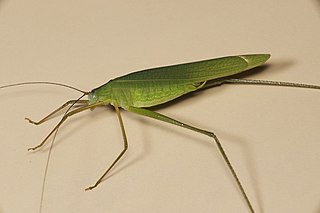
The orthopteran family Rhaphidophoridae of the suborder Ensifera has a worldwide distribution. Common names for these insects include jumping wētā, cave wētā, cave crickets, camelback crickets, camel crickets, Hogan bugs, spider crickets, land shrimp, and sand treaders. Those occurring in New Zealand and Australia are typically referred to as jumping or cave wētā. Most are found in forest environments or within caves, animal burrows, cellars, under stones, or in wood or similar environments. All species are flightless and nocturnal, usually with long antennae and legs. More than 500 species of Rhaphidophoridae are described.

The Tettigoniinae are a subfamily of bush crickets or katydids, which contains hundreds of species in about twelve tribes.

Trigonidiinae is a subfamily of insects in the order Orthoptera, suborder Ensifera, based on the type genus Trigonidium. They are often referred to as sword-tail crickets, winged bush crickets or trigs.

The subfamily Pseudophyllinae contains numerous species in the family Tettigoniidae, the katydids or bush crickets. Sometimes called "true katydids", together with the crickets of suborder Ensifera, they form part of the insect order Orthoptera which also contains grasshoppers.

The Phaneropterinae, the sickle-bearing bush crickets or leaf katydids, are a subfamily of insects within the family Tettigoniidae. Nearly 2,060 species in 85 genera throughout the world are known. They are also known as false katydids or round-headed katydids.

Gomphocerinae, sometimes called "slant-faced grasshoppers", are a subfamily of grasshoppers found on every continent but Antarctica and Australia.

Phalangopsinae, occasionally known as spider crickets, are a subfamily of crickets in the family Phalangopsidae. Members of Phalangopsinae are found worldwide in tropical and subtropical regions. Most species in the subfamily are nocturnal and can be found in rocky areas, near fallen wood, and the understory of forests. Some species are gregarious, gathering in large numbers.

Nemobiinae is a subfamily of the newly constituted Trigonidiidae, one of the cricket families. The type genus is Nemobius, which includes the wood cricket, but members of this subfamily may also be known as ground crickets or "pygmy field crickets".

Loxoblemmus is a genus of crickets in tribe Gryllini. Species can be found in Africa, Asia and Australia.

Conocephalinae, meaning "conical head", is an Orthopteran subfamily in the family Tettigoniidae.

Copiocerinae is a subfamily of short-horned grasshoppers in the family Acrididae. There are at least 20 genera in Copiocerinae, found in southern North America, Central America, and South America.

Podoscirtinae is a subfamily of crickets in the family Gryllidae.

Trigonidium is a large genus of sword-tail crickets, typical of the tribe Trigonidiini. Records of occurrence are from Europe, Africa, tropical Asia, Australia and the Pacific islands; many species endemic to Pacific islands including Hawaii have now been placed in the genus Nudilla.

Elimaea is a large genus within Tettigoniidae, the bush cricket or katydid family. Species in this genus are found in India, southern China, Indo-China and Malesia.
Anabropsis is a genus of king crickets in the tribe Anabropsini. They are found tropical areas of the Americas, Africa and Asia.
Rhaphidophora is the type genus of camel crickets in the tribe Rhaphidophorini.

The Phalangopsidae are a recently reconstituted family of crickets, based on the type genus PhalangopsisServille, 1831 from South America. Priority for family-group names based on this genus dates from Blanchard's "Phalangopsites".

Gryllacris is a genus of Orthopterans, sometimes known as 'leaf-folding crickets' in the family Gryllacridinae. It is the type genus for the family, tribe Gryllacridini and its subfamily.

Ornebius is a genus of crickets in the family Mogoplistidae and the tribe Arachnocephalini, erected by Félix Édouard Guérin-Méneville in 1844. Species may be called "common scaled crickets" and have widespread records of distribution, which are discontinuous ; they include: Africa, Asia, Australia, islands in the Indian and Pacific Oceans, and South America.















